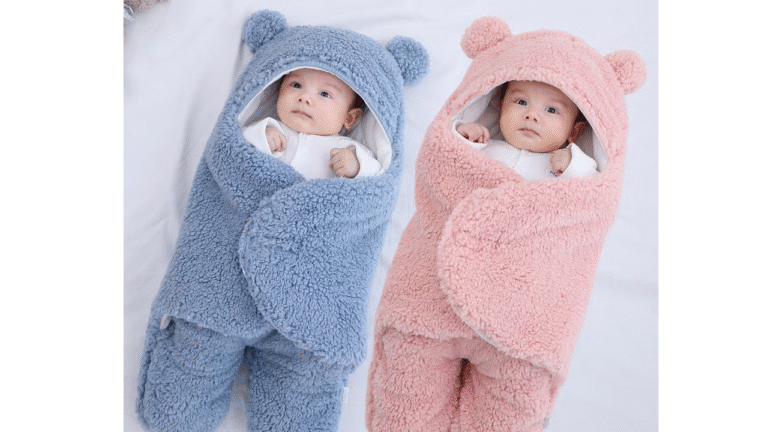A baby sleeping bag bag is a soft, sleeveless garment that zips around your baby and replaces the need for blankets in the crib. It ensures the baby remains covered all night without the risk of loose bedding. These bags come in various sizes, fabrics, and thickness levels to match the baby’s age, the room temperature, and seasonal needs.
Why Choose a Baby Sleeping Bag?
1. Safety First:
Traditional blankets can cover a baby’s face and pose a suffocation hazard. A baby sleeping bag eliminates this risk by staying securely on the baby’s body.
2. Promotes Better Sleep:
Since babies can’t kick off a baby sleeping bag, they stay at a consistent temperature all night. This helps prevent sudden wake-ups due to feeling too cold.
3. Easy to Use:
Most baby sleeping bags have zippers or snaps, making diaper changes during the night easier without fully undressing the baby.
4. Travel-Friendly:
Some sleeping bags are designed with slots for car seats or strollers, making it easier to keep the baby warm and undisturbed during travel.
Types of Baby Sleeping Bags
1. Seasonal Sleeping Bags
These are categorized by TOG ratings (Thermal Overall Grade), which indicate how warm the sleeping bag is.
-
0.5 TOG: For hot weather or rooms over 24°C.
-
1.0 TOG: Suitable for mild weather or rooms between 21°C–24°C.
-
2.5 TOG: Ideal for cooler climates or rooms between 16°C–20°C.
-
3.5 TOG: Best for winter or rooms under 16°C.
2. Swaddle Sleeping Bags
Designed for newborns who enjoy the feeling of being wrapped. These sleeping bags often come with wings or Velcro to mimic swaddling but with added mobility and safety.
3. Convertible Sleeping Bags
These can transform from a swaddle into a regular sleeping bag as your baby grows, offering more long-term use.
4. Travel Sleeping Bags
These come with rear openings or slots to use with car seats and strollers—perfect for on-the-go parents.
How to Choose the Right Baby Sleeping Bag
1. Size and Age Appropriateness
Always choose a sleeping bag according to your baby’s age and weight. Too big, and your baby may slip inside. Too small, and it may restrict movement.
2. TOG Rating for Temperature
Match the baby sleeping bag TOG rating with the room temperature. Overheating is dangerous for infants, so a sleeping bag that suits the environment is essential.
3. Fabric Type
Cotton, bamboo, and muslin are breathable, hypoallergenic, and soft on the baby’s skin. Organic options are available for parents seeking eco-friendly choices.
4. Easy Diaper Access
Look for bags with bottom zippers or two-way zippers to make nighttime changes more convenient.
5. Safety Certifications
Ensure the product meets safety standards such as OEKO-TEX certification, which guarantees no harmful chemicals are used.
Common Mistakes to Avoid
-
Using a sleeping bag that’s too warm for the room can cause overheating. Always monitor the baby’s temperature and use the right TOG.
-
Forgetting to check for wear and tear. Replace sleeping bags that show signs of damage, like broken zippers or holes.
-
Using extra blankets over the sleeping bag can defeat the purpose of a safer sleep setup.
FAQs About Baby Sleeping Bags
Q1: At what age can my baby start using a sleeping bag?
Babies can start using sleeping bags from birth, as long as the sleeping bag fits properly and is designed for their age and weight.
Q2: Can my baby roll over in a sleeping bag?
Yes, babies can roll safely in sleeping bags, provided the size is correct and the arms are free.
Q3: How many sleeping bags do I need?
Ideally, keep 2–3 sleeping bags for rotation, especially in case of leaks or spit-ups.
Q4: Can I use a sleeping bag if my baby has a cold?
Yes, but ensure the TOG rating is appropriate and avoid overdressing. Monitor the baby for signs of overheating or discomfort.
Q5: Are baby sleeping bags better than blankets?
Yes, for safety and consistent warmth, baby sleeping bags are generally considered a better option than loose blankets.
Conclusion
A baby sleeping bag is a smart investment for parents looking to provide safe and uninterrupted sleep for their baby. With so many styles, materials, and sizes available, it’s easy to find the perfect one to meet your baby’s needs. Just remember to choose the right TOG, size, and fabric, and you’ll have a cozy, well-rested baby in no time.

